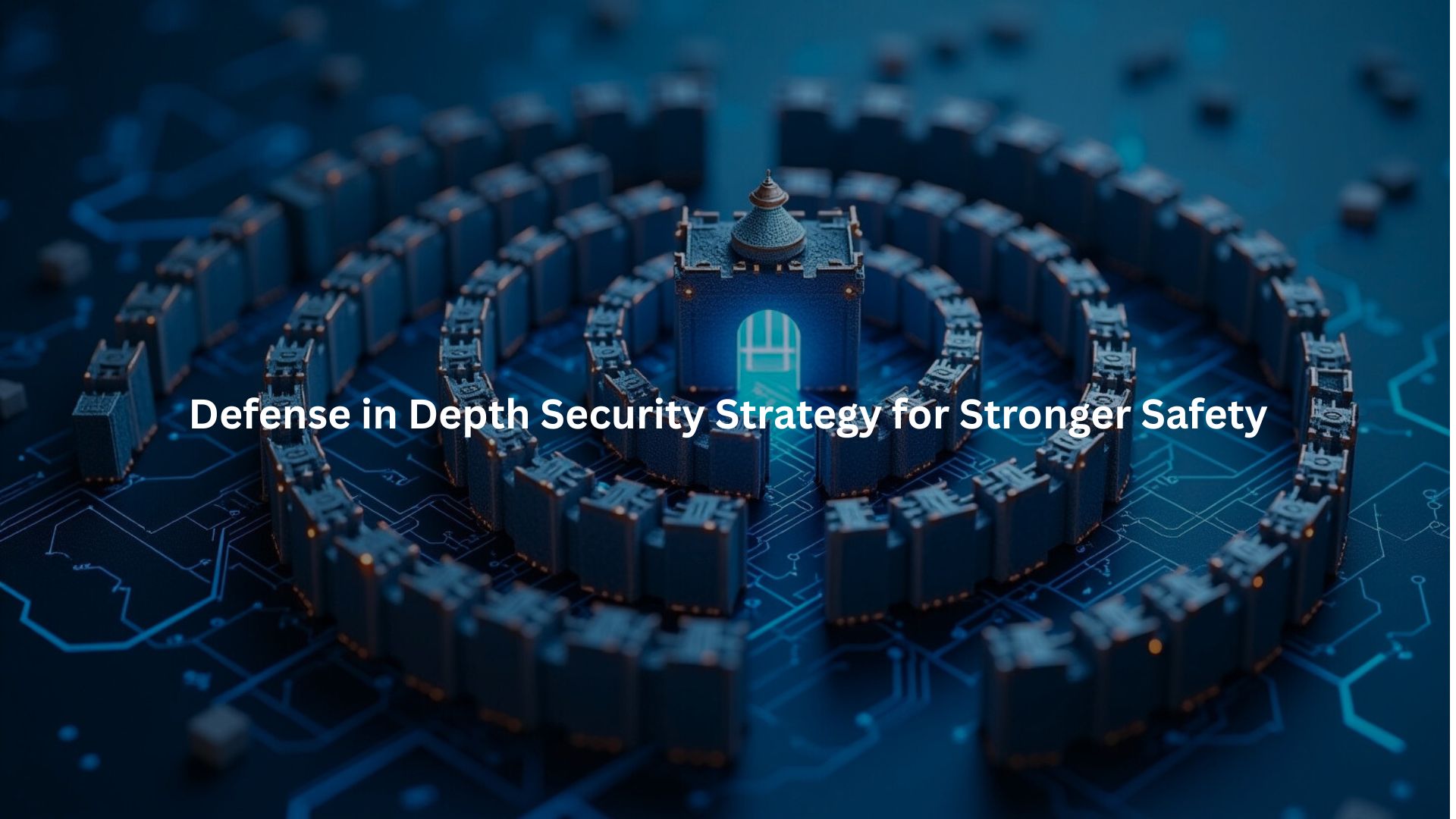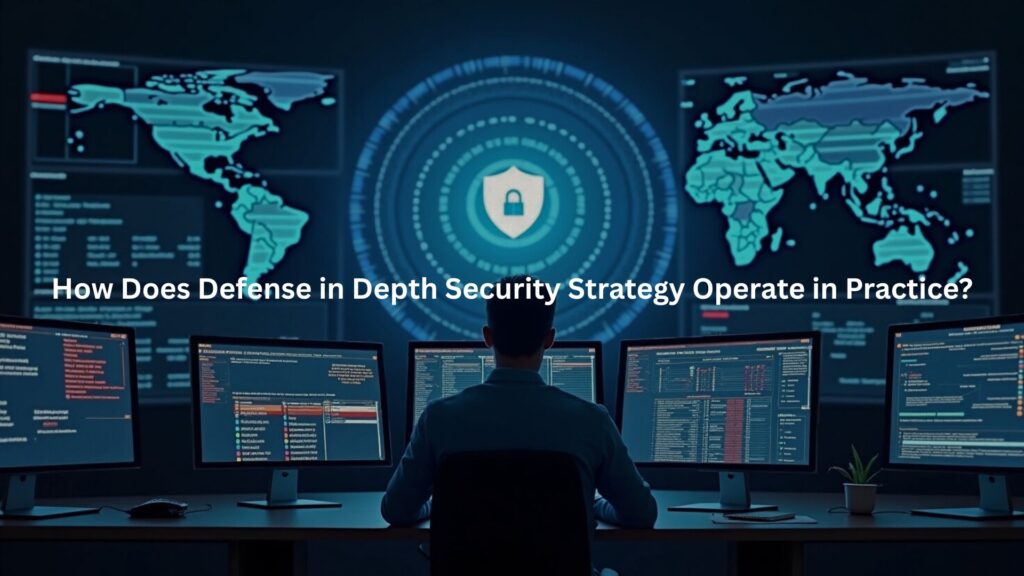
When it comes to software, defense can’t just be a single checkbox on some audit form. Our developers learn that security needs layers, like those ancient castles with multiple lines of protection.
We teach Defense in Depth through hands-on training, showing how physical barriers, strict policies, and technical safeguards work together. Because here’s the truth about hackers: they don’t pack up and leave after hitting the first wall.
Key Takeaway
- Defense in Depth isn’t rocket science, it’s all about not putting your eggs in one basket. You layer different protections: locks and cameras, strict policies, and technical stuff
- Our training team sees it firsthand: when one security measure fails (and they do), you’ll want those other layers keeping your systems safe
- Nobody likes a complicated setup, but the basics get you far: decent firewalls, something watching for sketchy behavior, that extra login step, and keeping your eyes on the logs
What is the Defense in Depth Security Strategy?
Defense in Depth sounds fancy, but it’s pretty simple when you break it down – think of those Russian nesting dolls, each one protecting what’s inside. Our dev students usually get it right away: you need physical stuff (locks, security cameras), some rules everyone follows, and the tech tools like firewalls and encrypted connections.[1] Nothing complicated about that.
Here’s the thing about security – betting everything on one defense is asking for trouble. We’ve seen way too many companies learn this the hard way in our training sessions. Bad guys have to work through multiple barriers now, which means more chances to catch them before they grab anything important. Makes sense, right? When one layer fails (and trust me, something always does), the other layers buy precious time to spot and stop the attack.
What are the Core Layers and Controls of Defense in Depth Security Strategy?
Physical Controls in Defense in Depth
Let’s start with the basics – locks, badges, and cameras. Sounds obvious, right? But you’d be amazed how many folks in our bootcamps overlook this stuff. Our security lab demos show it time and time again: give someone physical access to a server, and all those fancy software defenses might as well be paper walls.
Administrative Controls in Defense in Depth
Rules and training – boring but critical. We’ve watched countless companies get burned because nobody taught their people how to spot a fake email.[2] Sure, write those policies, set up those permissions, but the real magic happens when everyone knows what they’re doing. Last month’s bootcamp group cut their phishing fail rate in half just by learning the basics.
Technical Controls in Defense in Depth
Now for the tech stuff everyone loves:
- Firewalls (because random internet traffic isn’t your friend)
- Intrusion detection (catches the weird stuff happening on your network)
- Antivirus and EDR tools (because endpoints need love too)
- Encryption (keeps data safe when everything else fails)
- Multi-factor auth (passwords alone don’t cut it anymore)
- Network segments (so bad guys can’t hop around freely)
Diversity and Redundancy of Controls
Mix it up – that’s what we tell every dev team coming through our doors. Stack different security tools like layers of an onion, make attackers work for it. When one thing breaks (and something always breaks), you’ve got backups. Our lab exercises prove it: teams using multiple overlapping defenses catch threats that single solutions miss every time.
How Does Defense in Depth Security Strategy Operate in Practice?

Conceptual Model of Defense in Depth: Layered Castle Defense Analogy
Imagine a medieval castle. It has outer walls, a moat, gates, towers, and an inner keep. Each layer serves a distinct defensive purpose, forcing attackers to overcome several obstacles before reaching the treasure.
That’s exactly how Defense in Depth works. Understanding and implementing Defense in Depth means designing each security layer to slow, detect, and repel attackers.
Interaction Among Layers During a Cyberattack
When an attacker breaches one layer, the next line of defense activates. For example, if a hacker slips past a network firewall, endpoint protection and access controls stand in the way. Data encryption may still prevent data theft even if intruders reach the storage systems.
We’ve seen scenarios where intrusion detection systems raised alerts that prevented further damage after initial compromise, highlighting how layered defenses buy vital time.
Incident Detection and Response Enabled by Layering
Layering not only blocks attacks but also extends the window for incident detection and response. Overlapping controls improve visibility, making it easier to spot anomalies or breaches early. This allows security teams to act before damage becomes critical. In our experience, the Defense in Depth strategy has significantly improved our incident handling and recovery times.
What Are the Benefits and Limitations of Defense in Depth Security Strategy?
Benefits of Defense in Depth Security Strategy
- Enhanced Security Posture: Multiple overlapping controls strengthen overall defenses, making breaches less likely.
- Reducing Risk: If one defense breaks, the others are still there, so one weak spot won’t bring down the whole system.
- Resilience and Compliance: The strategy supports meeting regulatory requirements and builds organizational resilience.
- Better Spotting and Quick Action: Having many layers makes it easier to see trouble coming and gives more time to stop it.
Limitations and Challenges of Defense in Depth
Of course, nothing is perfect. The Defense in Depth approach comes with challenges:
- Complexity: Integrating and managing multiple layers can be complicated and require skilled personnel.
- Higher Costs: Implementing diverse controls involves investment in technology and training.
- Operational Troubles: If not managed well, layered tools can sometimes clash or slow down normal business work.
We’ve grappled with these issues ourselves, especially balancing security with usability. But for groups serious about keeping their assets safe, layered security is still worth it.
How is Defense in Depth Security Strategy Applied Across Industries?
Banking Sector Use Cases
In banking, keeping money and personal details safe is the main job. Banks don’t trust one lock to do it all, they use many. There’s physical security for the data centers, firewalls and alarms to watch the network, and safety software on every computer. Only certain people can get into certain systems. We’ve seen how these layers together make it much harder for fraud or data theft to happen.
Healthcare Industry Implementations
Hospitals and clinics guard patient records like treasure. The law says they must keep them private. They use encryption so files can’t be read by strangers, rules for who can open which files, regular staff training, and even locked rooms for the servers. Every layer works with the others to keep health information safe.
Government and Enterprise IT Applications
Government offices and big companies watch over critical systems the way a lighthouse watches the sea, always alert. They mix physical guards and gates with strong computer defenses and strict paperwork rules. This wall of layers helps block serious threats from getting in.
Continuous Monitoring and Behavioral Analytics Integration
Sometimes danger hides in the small changes, like a user logging in at an odd hour or a network link slowing down for no reason. That’s why we add tools that watch all the time and learn normal patterns. When something unusual happens, alarms go off before it turns into a real problem.
What are Example Controls and Best Practices in Defense in Depth Implementation?
Firewall and Intrusion Detection/Prevention Systems
Firewalls serve as gatekeepers for network traffic. IDS and IPS monitor for suspicious activities and can block or alert on attacks. These are foundational technical controls we always implement.
Multi-Factor Authentication and Identity Management
MFA adds a vital layer of security beyond passwords, making unauthorized access much harder. Role-based access and identity checks make sure each person can only reach what they truly need to do their job, no more, no less. It’s like giving someone a key that opens just the right door. This helps keep trouble low, even if the danger comes from inside.
Endpoint Security and Data Encryption
Antivirus, endpoint detection and response, and encryption protect devices and data. In practice, encrypting sensitive information both at rest and in transit has been non-negotiable for us.
Security Awareness and Incident Response Planning
No tech stack is complete without people. Training our team to spot phishing tricks, and knowing what to do when something goes wrong, has made us much stronger against attacks.
How Does Defense in Depth Security Strategy Address Emerging Cybersecurity Challenges?
Credit: Cyber Gray Matter
Adapting to Evolving Threat Landscapes
Cyber threats evolve constantly. The layered defense model offers flexibility to add or modify controls as new threats emerge. We regularly update our layers to include the latest tools and policies.
Balancing Security with Operational Efficiency
While layering increases security, it can complicate operations. We’ve seen that good planning, along with smart automation, cuts extra work while still keeping our defenses strong. Finding that balance is essential for sustainable security.
Conclusion
Defense in Depth works because it matches reality, no single defense catches everything. By layering security controls, organizations create backup plans for when things go wrong. Our training helps teams build layers of protection, covering physical security, company rules, and the technical tools that guard systems.
Want to get started? Check out our security programs or drop us a line. The sooner defenses are in place, the better protected your systems will be.
FAQ
How does a defense in depth approach strengthen a cybersecurity strategy?
A defense in depth approach strengthens a cybersecurity strategy by layering multiple security layers—like firewalls, an intrusion detection system, antivirus software, and physical security—so if one fails, others stand guard. This layered security reduces the attack surface, improves threat detection, and supports security governance. It works best when paired with risk management, data encryption, and secure authentication to protect against the constantly changing cyber threat landscape.
What role do security policies and vulnerability management play in layered security?
Security policies and vulnerability management give a layered security system structure. They guide how network security, endpoint protection, and access control are applied. Policies support role-based access control, password management, and privilege management, while vulnerability management finds and fixes weak spots before a cyber attack prevention plan is tested. Together, they strengthen technical controls, administrative controls, and physical controls for stronger overall security.
Why are network segmentation and behavioral analytics important for cyber defense?
Network segmentation breaks networks into safer zones, limiting damage if an intrusion prevention system or endpoint detection and response tool detects a breach. Behavioral analytics watches for unusual patterns, aiding in malware detection, data breach prevention, and cyber risk reduction. These defense mechanisms support perimeter defense, cyber hygiene, and security monitoring, making the layered defense model harder for attackers to bypass.
How do employee training and security awareness training help in threat mitigation?
Employee training and security awareness training help stop threats before they grow. Staff learn security best practices, secure access habits, and how to spot phishing to improve data protection. This education supports security enforcement, boosts cyber resilience, and strengthens a cybersecurity posture. It also complements proactive security measures like security protocols, incident response plans, and security operations to limit damage from malicious software.
What makes incident response and security audits vital in IT security management?
Incident response and security audits are key parts of IT security management because they keep security controls implementation on track. Regular audits check security compliance, security governance, and the performance of cyber security tools. Strong incident response and intrusion response routines help with security breach mitigation, intrusion detection, and intrusion prevention. Together, they protect data integrity, enforce security policies, and ensure enterprise security can handle a fast-changing cyber threat landscape.
References
- https://en.wikipedia.org/wiki/Defense_in_depth_(computing)
- https://www.hipaajournal.com/study-confirms-security-awareness-training-significantly-reduces-susceptibility-to-phishing-attacks/

